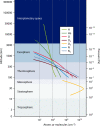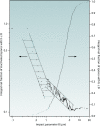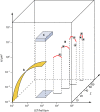Space microbiology
- PMID: 20197502
- PMCID: PMC2832349
- DOI: 10.1128/MMBR.00016-09
Space microbiology
Abstract
The responses of microorganisms (viruses, bacterial cells, bacterial and fungal spores, and lichens) to selected factors of space (microgravity, galactic cosmic radiation, solar UV radiation, and space vacuum) were determined in space and laboratory simulation experiments. In general, microorganisms tend to thrive in the space flight environment in terms of enhanced growth parameters and a demonstrated ability to proliferate in the presence of normally inhibitory levels of antibiotics. The mechanisms responsible for the observed biological responses, however, are not yet fully understood. A hypothesized interaction of microgravity with radiation-induced DNA repair processes was experimentally refuted. The survival of microorganisms in outer space was investigated to tackle questions on the upper boundary of the biosphere and on the likelihood of interplanetary transport of microorganisms. It was found that extraterrestrial solar UV radiation was the most deleterious factor of space. Among all organisms tested, only lichens (Rhizocarpon geographicum and Xanthoria elegans) maintained full viability after 2 weeks in outer space, whereas all other test systems were inactivated by orders of magnitude. Using optical filters and spores of Bacillus subtilis as a biological UV dosimeter, it was found that the current ozone layer reduces the biological effectiveness of solar UV by 3 orders of magnitude. If shielded against solar UV, spores of B. subtilis were capable of surviving in space for up to 6 years, especially if embedded in clay or meteorite powder (artificial meteorites). The data support the likelihood of interplanetary transfer of microorganisms within meteorites, the so-called lithopanspermia hypothesis.
Figures

















References
-
- Adams, A. P., and J. C. Spendlove. 1970. Coliform aerosols emitted by sewage treatment plants. Science 169:1218-1220. - PubMed
-
- Allen, C. A., C. L. Galindo, U. Pandya, D. A. Watson, A. K. Chopra, and D. W. Niesel. 2007. Transcription profiles of Streptococcus pneumoniae grown under different conditions of normal gravitation. Acta Astronaut. 60:433-444.
-
- Aponte, V. M., D. S. Finch, and D. M. Klaus. 2006. Considerations for non-invasive in-flight monitoring of astronaut immune status with potential use of MEMS and NEMS devices. Life Sci. 79:1317-1333. - PubMed
-
- Arrhenius, S. 1903. Die Verbreitung des Lebens im Weltenraum. Umschau 7:481-485.
-
- Artemieva, N. A., and B. A. Ivanov. 2004. Launch of Martian meteorites in oblique impacts. Icarus 171:183-196.
Publication types
MeSH terms
LinkOut - more resources
Full Text Sources
Molecular Biology Databases

